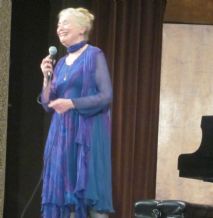|
Symphony
FROM THE NEW WORLD TO THE OLD WORLD
by Peter Lert
Saturday, June 14, 2025
Chamber
MC2 DUO RECITAL CLOSES 222'S SEASON
by Terry McNeill
Saturday, June 14, 2025
Choral and Vocal
CANTIAMO SONOMA'S LUSCIOUS A CAPELLA SINGING IN SEASON ENDING CONCERT
by Pamela Hicks Gailey
Sunday, June 8, 2025
Symphony
SRS SEASON ENDS WITH RESOUNDING TA-TA-TA-BANG
by Terry McNeill
Sunday, June 1, 2025
Symphony
YOUTHFUL VIRTUOSITY ON DISPLAY AT USO'S MAY CONCERTS
by Peter Lert
Saturday, May 17, 2025
Symphony
MYSTICAL PLANETS AND LIVELY GERSHWIN ORTIZ AT FINAL SRS CONCERT
by Peter Lert
Sunday, May 4, 2025
Symphony
VSO'S CONCERT MUSIC OF TIME, MUSIC OF PLACE
by Peter Lert
Sunday, April 27, 2025
VOCAL ELEGANCE AND FIRE AT THE 222'S RECITAL APRIL 26
by Pamela Hicks Gailey
Saturday, April 26, 2025
CANTIAMO SONOMA SINGS AN INSPIRED GOOD FRIDAY MOZART REQUIEM CONCERT
by Pamela Hicks Gailey
Friday, April 18, 2025
DRAMATIC SHOSTAKOVICH SYMPHONY CLOSES PHILHARMONIC'S 25TH SEASON
by Terry McNeill
Sunday, April 13, 2025
|
 |
 Barbara Nissman On The Oakmont Stage June 14 |
VIRTUOSIC PROKOFIEV AND LISZT IN NISSMAN'S OAKMONT RECITAL
by Terry McNeill
Thursday, June 14, 2012
Barbara Nissmanís pianism is best heard on her own terms, with little comparison to current performance practices. This was in evidence June 14 when the venerable West Virginia artist returned to Sonoma County, playing a long recital in the Oakmont Concert Series before 160 in Berger Auditorium.
The recital was long because of the artistís spoken introduction (both incisive and silly) and because the program was packed with pieces associated with Ms. Nissmanís lengthy career, beginning with study under the Bartok specialist Gyorgy Sandor.
Liszt's transcription of Bach's A Minor Prelude and Fugue (BWV 543) opened the program, a propitious choice. Though piano transcriptions of Bach's organ works from d'Albert, Petri and Busoni were once popular, the Liszt work is the one currently heard and Ms. Nissman gave it a wonderful performance, stressing contrapuntal clarity over sonority. The artist lacks a big sound at the piano and during the entire concert there wasn't a true fortissimo. No matter, clarity prevailed through the repetitive phrasing of the Prelude and there were some beguiling staccato touches in the Fugue. An auspicious and captivating beginning.
Ms. Nissman is billed as a Romantic pianist but Beethovenís C-Sharp Minor Sonata (Moonlight) was the antithesis of a romantic interpretation, and the cantabile first movement was played fast and almost without rubato, the shift pedal used throughout. The sprightly rhythms of the middle Allegretto were put into high relief with sharp changes in volume and bouncy clarity. In the finale (Presto Agitato) the broken chords were played masterfully and the entire movement had drama, albeit without the last ounce of power.
Six of Prokofiev's Visions Fugitives (Op. 22) and his Op. 28 Third Sonata closed the first half. Ms. Nissman has long been identified with the Russian's compositions and played everything superbly, eliciting in the Visions, each fewer than two minutes, disparate and complex pianistic vignettes. In No.1 Ms. Nissman found a droll, wandering scene, and the nostalgia of the eighth. Toccata rhythms of percussive dissonance were brought out in No. 14, and a Satie-like lethargy of the concluding No. 1.
Prokofievís one-movement Op. 28 Sonata has always been a Nissman specialty and she began at a fast clip, the bright and dry piano sound ideal for the driving tempest of the work. Here the artist and composer became one and I cannot remember a better performance of this pointillist and virtuosic Sonata. The accelerando in the coda was potent, the bravura intoxicating.
Three Rachmaninoff Preludes, all in a variant of G, began the second half. The popular and bucolic G major from Op.32 had many individual touches and a unique rush in the concluding bars. The G-Sharp Minor Prelude, from the same set, drew an evocative sound of troika bells and the pianist stressed the cool colors of the work, long associated with Horowitz. From Op. 23, the concluding G-Flat Major Prelude had the requisite lyricism but was also a prosaic in phrasing, needing a touch of repose.
The afternoon's major work, Liszt's B Minor Sonata, surprisingly closed the recital as it usually closes the first half. Quiet endings are seldom part of a final work in a piano recital. Santa Rosa has recently heard the Sonata in the hands of Bronfman, Ohlsson, Hewitt, Spooner and also eight years ago from Ms. Nissman in SRJC's Newman Auditorium. Her performance hasn't changed much, and was again individual in the approach to exhibiting reserved dynamics, attention to structure at the expense of heroics and brilliant scale passages. The artist sporadically sounded frenetic in rapid octaves (forceful but not majestic) but they never failed her, and the velocity of the fugue was compelling. Ms. Nissman worked hard to get color from the hallís piano treble, with some success, and her legato playing was seductive. In sum, and unconventional and at times perplexing reading of this great work that on balance succeeded because of her strong individual vision.
Applause was large but not loud, but Ms. Nissman was determined to perform Ginastera, choosing the final two of the Dances Argentinas (Op.2) as encores. Associated with the prolific Argentine composer for decades, the pianist played the popular Danza de la Moza donosa and Danza del gaucho matero with palpable energy and attractive guitar-like rhythms. As in the Prokofiev, identification with the works was total and the playing ne plus ultra.
|

